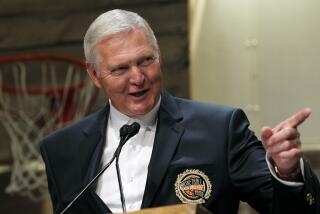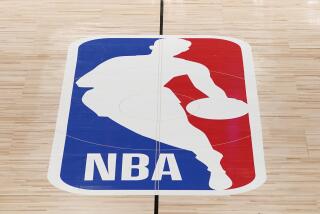The NBA’s bling ban: looking good
- Share via
I RECENTLY stayed at the 137-year-old New York Athletic Club in Manhattan to attend a board meeting of the Mystery Writers of America. This traditional private club requires men to wear jacket, slacks and collared shirt. Women also have to dress accordingly. Before the meeting, board members exchanged e-mails on how quaint and retro the dress code was.
David Stern, the commissioner of the National Basketball Assn., doesn’t think dress codes are quaint. His new edict forbids league players from wearing “bling” — chains, pendants and medallions, among other items. The ban is an attempt to rehabilitate the image of a sport beset with bad behavior, including a brawl between Detroit fans and Indiana players, Kobe Bryant’s sexual-assault trial, Allen Iverson brandishing a pistol while hunting for his wife, and Jason Kidd’s much-publicized domestic violence problems.
Image equals money in business. In pro basketball, where mostly young black athletes entertain middle-aged, upscale white men, something had to give — and Stern was not about to get a tat and a diamond stud in his ear lobe.
“All that stuff that goes on — it’s like gangster, thuggery stuff,” Lakers Coach Phil Jackson said of the regalia favored by some players in the league.
Outside the NBA, the gangsta-rap look has spread not only among inner-city black and Latino youth but also among their middle-class counterparts, black, white or Asian. But it’s inner-city youth who mostly bear the consequences of the look — stopped routinely by police, mistaken for a gangbanger by other gangbangers and prejudged when they fill out a job application.
Just because spoiled, overpaid and overindulged pro athletes wear gangsta gear doesn’t mean they don’t need a reality check. Stern’s motives are about profit, but his ban on bling offers an opportunity for the players to reflect.
A job, no matter how cool, demands a certain professionalism and sacrifice. Marcus Camby, the Denver Nuggets center, said he and his teammates would need a clothing stipend to buy business-casual attire to comply with the new rules. This from a guy who signed a six-year, $45-million contract.
Yet the reality is that more kids know Iverson’s game-point average than about civil rights pioneer Medgar Evers or crusading newspaperwoman Ida B. Wells-Barnett. Retired NBA veterans Charles Barkley and Michael Jordan have implored current players to realize that they have responsibilities as role models — and to dress accordingly.
Hip-hop as a cultural phenomenon has reinvigorated the music industry and energized other forms of pop culture. I’s here to stay. But like any art form, it has to be self-reflective and critical if it’s going to push the boundaries and not just parody itself.
The NBA’s gifted ballers need to start reading more than the latest Escalade brochure and worrying about more than how their spinners gleam. Thinking critically is not just learning complicated offenses to dazzle spectators. It also means not being blinded by the bling in order to be inspiring off the court as well.
More to Read
Sign up for Essential California
The most important California stories and recommendations in your inbox every morning.
You may occasionally receive promotional content from the Los Angeles Times.










